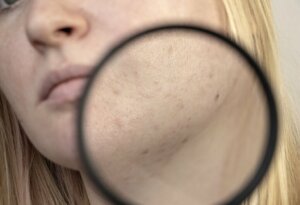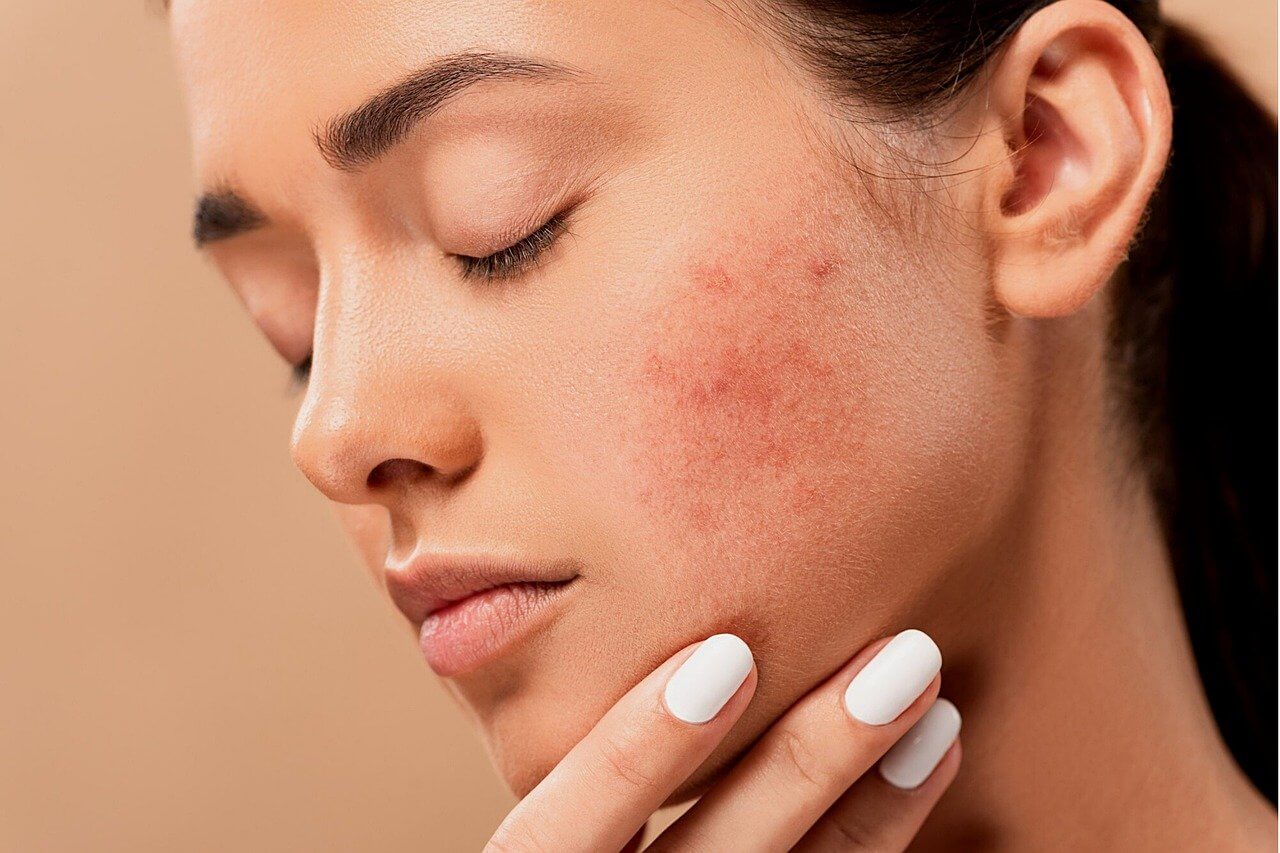How Is Acne Diagnosed?

Acne is a skin disease characterized by the appearance of comedones and pustules in regions such as the face, chest, and back. This pathology is one of the most frequent reasons for consultation in the area of dermatology. But how is acne diagnosed? Keep reading!
The condition in question can appear for various causes, being closely related to the obstruction of the skin pores and hormonal variations. Acne generally appears in visible areas of the skin and has a characteristic inflammatory process, making it very easy to recognize.
Some studies establish that this pathology can affect up to 85% of Americans at some point in their life. In this sense, we can say that it’s one of the easiest pathologies to recognize and that the general population tends to self-diagnose without having to go to a specialist.
How is acne diagnosed?

Acne is one of the most common diseases, especially in teenagers. Its high prevalence makes it a very easy pathology to diagnose, even if you don’t have adequate medical knowledge.
Despite the fact that a person can diagnose the disease accurately, it’s always necessary to go to a dermatologist. Only the specialist will be able to make an accurate diagnosis of the type of acne that the person is suffering from, and, in turn, initiate the appropriate treatment for it.
Now you may be wondering, how does the dermatologist diagnose acne? Well, they will look into the person’s medical history and carry out a thorough inspection of the lesions. Both steps are essential when it comes to differentiating acne from other pathologies.
Medical history and questioning
The person’s medical history is one of the fundamental tools every doctor has, where they’ll be able to access all patient’s information. These data are useful when diagnosing any disease and establishing the treatment to be followed to resolve it.
In the specific case of acne, the doctor must first inquire about the appearance of the lesions and the affected areas. It’s also important to determine the presence of any pathology associated with acne such as polycystic ovary syndrome or the consumption of drugs such as corticosteroids.
On the other hand, the specialist should ask if a close relative suffered from acne at any time in their life. This is because some research has shown the relationship between certain genes and the presence of acne in some adolescents.
Physical exam
The physical examination of acne is a faster and simpler procedure than looking at a patient’s medical history. It will consist of the inspection of the injuries and the affected areas. It’s most advisable that the patient doesn’t manipulate these lesions in any way, as they can produce even greater damage to the skin.
The inspection will help the dermatologist to assess the severity of the inflammatory process and determine the stage of the disease. The specialist should also look for signs of other pathologies that may explain the presence of acne, such as an increase in certain hormones or pregnancy.
Laboratory studies
A dermatologist diagnoses acne just by using the two steps already described. In this way, a culture of the lesions, laboratory analysis, and imaging studies aren’t usually necessary for a routine inspection.
There are certain exceptions to this general rule, which are important to keep in mind. The dermatologist may request a culture of the lesions in cases where the acne is very severe and doesn’t improve with the usual treatment. This will be in order to determine the etiological agent and to try to eradicate it with a more aggressive drug.
Tests of hormone levels in the blood are only recommended in patients who have signs of excess androgens. In addition, imaging tests such as computed tomography will only be required when the presence of a tumor that explains the hormonal imbalances is suspected.
What are the differential diagnoses?

Although acne is diagnosed quickly and easily, the lesions that the disease causes can be confused with other pathologies. All these conditions have different treatments, so it’s very important to learn to differentiate them from one another.
One of the pathologies that can be confused with acne is rosacea, also known as adult acne. It’s nothing more than the reddening of the skin of the face with the subsequent appearance of papules and pustules.
Folliculitis can be confused with acne. It’s simply the inflammation and infection of one or more hair follicles. This condition is more common in men who have oily skin and a thick beard. Other conditions with which a differential diagnosis should be made include the following:
- Some types of dermatitis
- Increase in the size of the sebaceous glands
- Keratosis pilaris
- Allergic outbreaks or as a result of drugs
An easy to diagnose pathology
As acne is one of the most common pathologies, millions of people know exactly what it looks like, and that’s why we can diagnose it so quickly. In most cases, it’s only necessary to inspect the affected area to confirm the presence of the disease and the degree of the outbreak.
This disease can leave severe scars in the affected area, and so it’s vitally important to keep a constant check with the dermatologist. Only this specialist will be able to inspect and indicate the appropriate treatment for acne, in order to avoid aesthetic consequences.
Acne is a skin disease characterized by the appearance of comedones and pustules in regions such as the face, chest, and back. This pathology is one of the most frequent reasons for consultation in the area of dermatology. But how is acne diagnosed? Keep reading!
The condition in question can appear for various causes, being closely related to the obstruction of the skin pores and hormonal variations. Acne generally appears in visible areas of the skin and has a characteristic inflammatory process, making it very easy to recognize.
Some studies establish that this pathology can affect up to 85% of Americans at some point in their life. In this sense, we can say that it’s one of the easiest pathologies to recognize and that the general population tends to self-diagnose without having to go to a specialist.
How is acne diagnosed?

Acne is one of the most common diseases, especially in teenagers. Its high prevalence makes it a very easy pathology to diagnose, even if you don’t have adequate medical knowledge.
Despite the fact that a person can diagnose the disease accurately, it’s always necessary to go to a dermatologist. Only the specialist will be able to make an accurate diagnosis of the type of acne that the person is suffering from, and, in turn, initiate the appropriate treatment for it.
Now you may be wondering, how does the dermatologist diagnose acne? Well, they will look into the person’s medical history and carry out a thorough inspection of the lesions. Both steps are essential when it comes to differentiating acne from other pathologies.
Medical history and questioning
The person’s medical history is one of the fundamental tools every doctor has, where they’ll be able to access all patient’s information. These data are useful when diagnosing any disease and establishing the treatment to be followed to resolve it.
In the specific case of acne, the doctor must first inquire about the appearance of the lesions and the affected areas. It’s also important to determine the presence of any pathology associated with acne such as polycystic ovary syndrome or the consumption of drugs such as corticosteroids.
On the other hand, the specialist should ask if a close relative suffered from acne at any time in their life. This is because some research has shown the relationship between certain genes and the presence of acne in some adolescents.
Physical exam
The physical examination of acne is a faster and simpler procedure than looking at a patient’s medical history. It will consist of the inspection of the injuries and the affected areas. It’s most advisable that the patient doesn’t manipulate these lesions in any way, as they can produce even greater damage to the skin.
The inspection will help the dermatologist to assess the severity of the inflammatory process and determine the stage of the disease. The specialist should also look for signs of other pathologies that may explain the presence of acne, such as an increase in certain hormones or pregnancy.
Laboratory studies
A dermatologist diagnoses acne just by using the two steps already described. In this way, a culture of the lesions, laboratory analysis, and imaging studies aren’t usually necessary for a routine inspection.
There are certain exceptions to this general rule, which are important to keep in mind. The dermatologist may request a culture of the lesions in cases where the acne is very severe and doesn’t improve with the usual treatment. This will be in order to determine the etiological agent and to try to eradicate it with a more aggressive drug.
Tests of hormone levels in the blood are only recommended in patients who have signs of excess androgens. In addition, imaging tests such as computed tomography will only be required when the presence of a tumor that explains the hormonal imbalances is suspected.
What are the differential diagnoses?

Although acne is diagnosed quickly and easily, the lesions that the disease causes can be confused with other pathologies. All these conditions have different treatments, so it’s very important to learn to differentiate them from one another.
One of the pathologies that can be confused with acne is rosacea, also known as adult acne. It’s nothing more than the reddening of the skin of the face with the subsequent appearance of papules and pustules.
Folliculitis can be confused with acne. It’s simply the inflammation and infection of one or more hair follicles. This condition is more common in men who have oily skin and a thick beard. Other conditions with which a differential diagnosis should be made include the following:
- Some types of dermatitis
- Increase in the size of the sebaceous glands
- Keratosis pilaris
- Allergic outbreaks or as a result of drugs
An easy to diagnose pathology
As acne is one of the most common pathologies, millions of people know exactly what it looks like, and that’s why we can diagnose it so quickly. In most cases, it’s only necessary to inspect the affected area to confirm the presence of the disease and the degree of the outbreak.
This disease can leave severe scars in the affected area, and so it’s vitally important to keep a constant check with the dermatologist. Only this specialist will be able to inspect and indicate the appropriate treatment for acne, in order to avoid aesthetic consequences.
- Zhang M, Qureshi AA, Hunter DJ, Han J. A genome-wide association study of severe teenage acne in European Americans. Hum Genet. 2014;133(3):259-64.
- Pozo Román T. Protocolo del acné. ADOLESCERE: Revista de Formación Continuada de la Sociedad Española de Medicina de la Adolescencia. 2014; 2(3): 30-36.
- De los Santos C. Diagnóstico y tratamiento del acné. Tendencias en medicina. 2016; 25(49): 95-101.
- Ramírez Hernández W. Manejo y tratamiento del acné ( bases para el diagnóstico y tratamiento). Revista Médica de Costa Rica y Centroamérica. 2014; 71(609): 107-110.
- Titus S, Hodge J. Diagnosis and treatment of acne. Am Fam Physician. 2012 Oct 15;86(8):734-40.
- Eichenfield LF, Krakowski AC, Piggott C, Del Rosso J et al. Evidence-based recommendations for the diagnosis and treatment of pediatric acne. Pediatrics. 2013;131 Suppl 3:S163-86.
Este texto se ofrece únicamente con propósitos informativos y no reemplaza la consulta con un profesional. Ante dudas, consulta a tu especialista.







